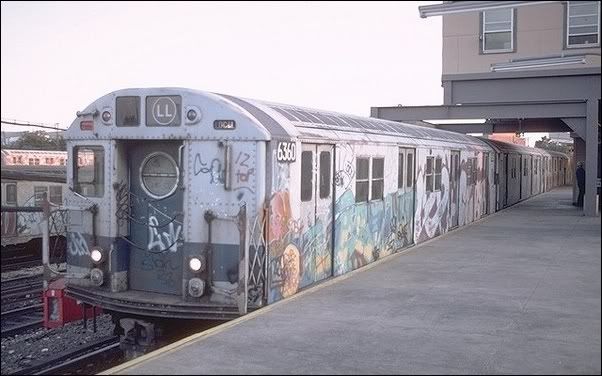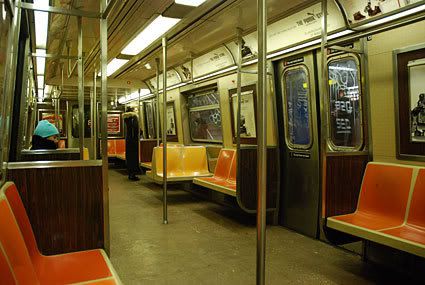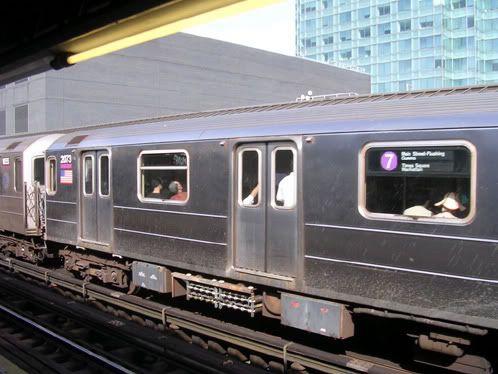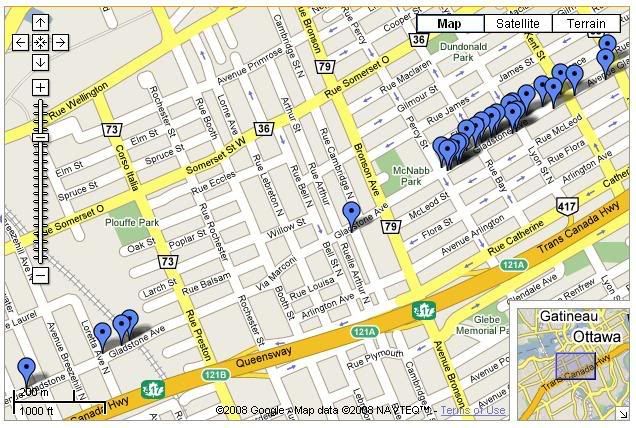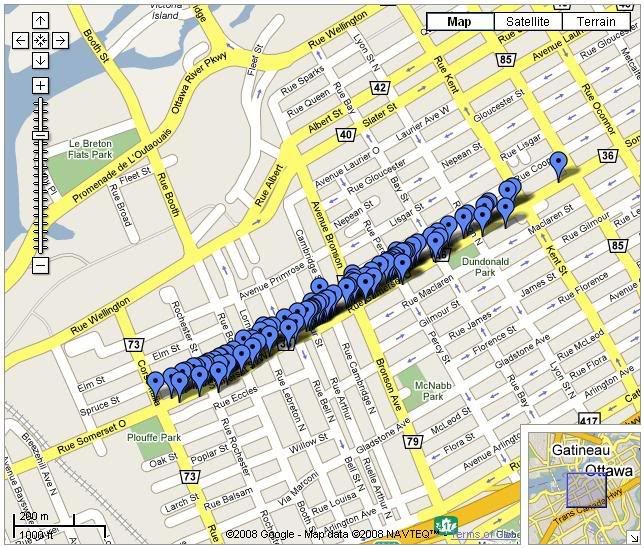- Markers
- Spray Paint
- Stickers
- Scratching (or Scratchiti)
Markers

Markers can be ink-based or paint-based; and paint-based marker can also be liquid paint or solid paint (which leave a thicker residue and are effective on rough surfaces).
Markers are used to leave quick tags.
Solid paint markers can be used on both flat and rough surfaces. Liquid ink and paint markers are typically used on flat surfaces. Liquid markers can be felt-tipped or mop-tipped. A felt-tipped marker is like a typical Sharpie or Pilot...but of a larger format. Mop-tipped markers have a sponge tip or “mop” (like on a shoe polish bottle or bingo daubber) and can come in squeezable containers to create stylized drips. Markers can be regular art supplies or specialized graffiti-specific markers (which are sold by custom graffiti suppliers [e.g., Molotow, Krink, Junobo, On the Run] or custom fashioned by graffiti writers from shoe polish bottles/bingo daubers and ink/paint). To make graffiti-specific marks more destructive and indelible the ink and paint used in them is typically supplemented with brake fluid to leave permanent stains on surfaces.
Spray Paint
 Spray paint is used for creating large complex graffiti pieces...but they can also be used to throw-up quick tags. For this reason spray paint is a highly-prized graffiti medium, as it is versatile and also used for prestige work (like bombing or aggressively tagging all businesses on a street, or for putting up complex time-consuming pieces). Graffiti writers typically use spray paint on porous surfaces (for which most markers wouldn't be ideal) like stucco, brick, cement, and stone. Spray paints are often weather-proof or rust-resistant (for metal surfaces, like Rust-oleum or Rusto, and Tremclad) or have custom-designed colours created by graffiti-specialty suppliers (e.g., Krylon, Montana, Molotow).
Spray paint is used for creating large complex graffiti pieces...but they can also be used to throw-up quick tags. For this reason spray paint is a highly-prized graffiti medium, as it is versatile and also used for prestige work (like bombing or aggressively tagging all businesses on a street, or for putting up complex time-consuming pieces). Graffiti writers typically use spray paint on porous surfaces (for which most markers wouldn't be ideal) like stucco, brick, cement, and stone. Spray paints are often weather-proof or rust-resistant (for metal surfaces, like Rust-oleum or Rusto, and Tremclad) or have custom-designed colours created by graffiti-specialty suppliers (e.g., Krylon, Montana, Molotow).
Stickers
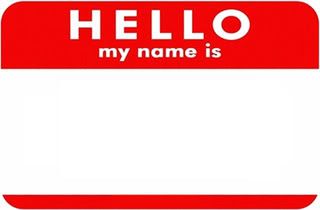 Graffiti can also be created with stickers. Because stickers can be created at home, street artists will also use stickers as a medium to create intricate artwork to place out on public surfaces. The line between street art and graffiti is fine, and open to personal perspective...some people find street art to be rich and vibrant, adding colour and style to the hum-drum surfaces of our modern city. Stickers can either plastic or paper-based. Plastic-stickers are typical made and orderd from a custom supplier and are weather resistant. Paper-based stickers are cheaper and can be purchased at dollar stores (e.g., name-tag stickers) or procured for free using postal service label stickers that are provide free of charge to the public. Custom-sized stickers can then be created by layering sticker upon sticker. Once ready, stickers can then be applied to any flat surface (metal, plastic, glass). Often stickers will be affixed to public street furniture (the backs of street signs, postal equipment [relay points, street letter boxes, drop boxes], telephone equipment [telephone booths, telephon switch boxes], hydro transmission boxes, newspaper boxes, bus shelters, lighting poles). As paper-based sticker fade and degrade from the sun and rain, they are often placed indoors (e.g., in bathrooms) or in sheltered areas (e.g., on the inside window of a newspaper box) where the elements won't impact them as much.
Graffiti can also be created with stickers. Because stickers can be created at home, street artists will also use stickers as a medium to create intricate artwork to place out on public surfaces. The line between street art and graffiti is fine, and open to personal perspective...some people find street art to be rich and vibrant, adding colour and style to the hum-drum surfaces of our modern city. Stickers can either plastic or paper-based. Plastic-stickers are typical made and orderd from a custom supplier and are weather resistant. Paper-based stickers are cheaper and can be purchased at dollar stores (e.g., name-tag stickers) or procured for free using postal service label stickers that are provide free of charge to the public. Custom-sized stickers can then be created by layering sticker upon sticker. Once ready, stickers can then be applied to any flat surface (metal, plastic, glass). Often stickers will be affixed to public street furniture (the backs of street signs, postal equipment [relay points, street letter boxes, drop boxes], telephone equipment [telephone booths, telephon switch boxes], hydro transmission boxes, newspaper boxes, bus shelters, lighting poles). As paper-based sticker fade and degrade from the sun and rain, they are often placed indoors (e.g., in bathrooms) or in sheltered areas (e.g., on the inside window of a newspaper box) where the elements won't impact them as much.
Scratching (Scratchiti) and Etching
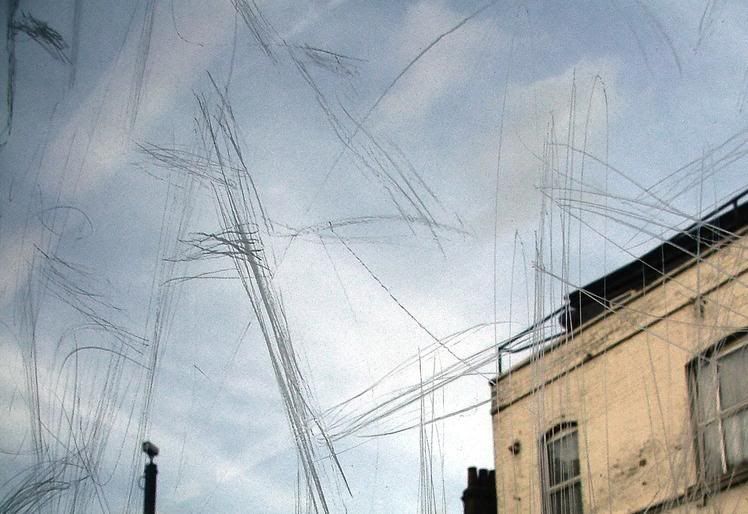 Graffiti can be made on glass, plastic and metal surfaces (as ink and paint can be easily removed from these surfaces) by scratching into these surfaces with a glass-cutter or a sharp blade. Additionally sometimes acid etching is used to graffiti glass, plastic and metal through the application of hazardous toxic solvents.
Graffiti can be made on glass, plastic and metal surfaces (as ink and paint can be easily removed from these surfaces) by scratching into these surfaces with a glass-cutter or a sharp blade. Additionally sometimes acid etching is used to graffiti glass, plastic and metal through the application of hazardous toxic solvents.

